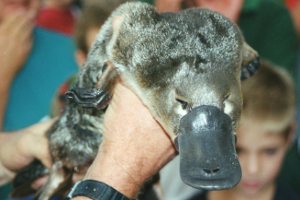 I couldn’t think of a better example of an extreme mammal than a Platypus.Image from Wikimedia Commons. / CC Attribution-Share Alike 3.0 Unported
I couldn’t think of a better example of an extreme mammal than a Platypus.Image from Wikimedia Commons. / CC Attribution-Share Alike 3.0 Unported
I have a sweatshirt I love hanging in my closet. It has small pictures of an alligator, duck, beaver, and snake. It says – with our powers combined, we are PLATYPUS! I couldn’t think of a better example of an extreme mammal than a Platypus. It is so unusual that when Europeans first encountered the species in 1798, it was thought to be a hoax. Captain John Hunter sent a pelt and sketch to scientists in Great Britain. They were dumbfounded. One scientist, Robert Shaw even took scissors to the skin to check for stitches as he thought it was an ingenious fake. And even in nature it looks out of place, with the beak of a duck, the body and fur of a beaver, the behavior of an alligator, it seems to be nothing more than a mish-mosh. Which holds a grain of truth, for the Platypus sports attributes that thwart its classification as a mammal. Below are some of the more unique features of this species…
The Platypus is semi-aquatic. It forages for food in the water, swimming smoothly with its webbed feet. However, it can fold back its webbing on it feet when walking on land and clutch the earth with its nails. Its legs are on the sides of its body rather than underneath its body like other mammals. It can run on land using knuckle walking. Its gait resembles an alligator more than a mammal like a beaver. Moreover, the Platypus lays eggs that resemble those of reptiles. Like reptilian eggs, only part of the egg of a Platypus divides as it develops. The Platypus is one of the only mammals in the world to lay eggs rather than giving birth to live young.
It is also one of the only mammals to be venomous! Both female and males of the species have a spur on their hind foot. The female loses this spur after about three months to a year but the male Platypus’s spur develops venom that can deliver excruciating pain. This venom is different than venoms in reptiles as it is not life threatening and doesn’t seem to be used for predation. Instead the production of venom corresponds to mating seasons and seems to be used for male dominant displays.
For predation, the Platypus relies on its sensitive bill. The Platypus closes its eyes, ears, and nose while in the water, so it does not hunt by sight, sound, or smell. It has electroreceptors that detect tiny electrical currents given off by the muscular contractions of its prey. Being sensitive to these currents, it is able to differentiate between animate and inanimate objects and feed accordingly. The Platypus is a carnivore and forages for worms, insects, larvae, shrimp and other shellfish. Feeding becomes even more interesting as the Platypus has no teeth. They will store caught prey, mud and bits of gravel in pouches in their cheek until they surface from the water. They will then use the debris and gravel to “chew” their food.
